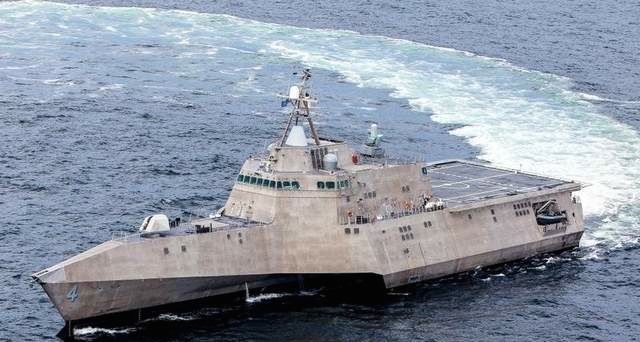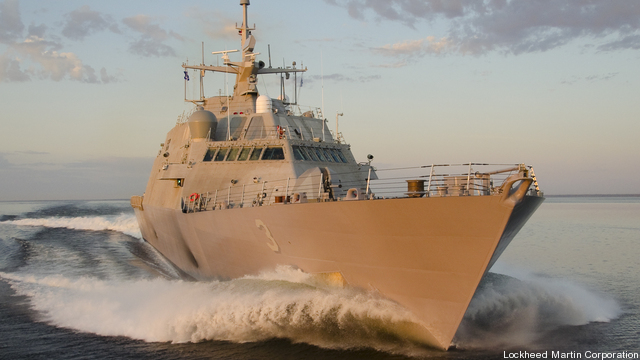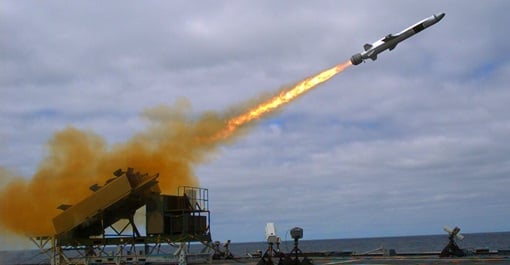LCS: HASC Seapower Chair Praises Frigate Delay
Posted on

LCS-4, USS Coronado
CAPITOL HILL: The Navy’s decision to slow down its LCS frigate program is “reassuring,” the chairman of the House seapower subcommittee said yesterday evening. Delaying contract award from 2019 to 2020 gives the service more time to do “due diligence” on the designs, Rep. Rob Wittman told reporters after a hearing on the Littoral Combat Ship.
The extra time not only reduces the risk of mistakes that would require costly rework, Wittman went on: It also gives the Navy and the shipyards to fully explore options such as heavier armament — potentially including heavy-duty Vertical Launch System missile tubes. While there are other launchers, VLS accommodates not only the Navy’s largest missiles but also the widest variety of weapons, from anti-aircraft to anti-submarine, from missile defense to land attack.
“It’s reassuring in the sense that we want to make sure that we go through the proper due diligence,” Wittman said of the delay. “(We need) a good discourse between Congress, the industry, and the Navy about what’s the requirement…. so I have no problem with taking a little bit of additional time.”
That way, Wittman went on, “when we go to award and construction starts, design’s gonna be mature, we truly understand the requirements set, all the competitors understand what the needs are and how they can put out their proposals there, and we end up with the best decision.”

LCS-3 Fort Worth, the monohull variant built by Marinette.
More Time, More Options
Just two weeks ago, the Government Accountability Office, Congress’s watchdog, issued an updated argument that the Navy was moving too fast to upgrade the current, controversial LCS to a frigate and urged a year’s delay. Yesterday, the head of the LCS program, Rear Adm. John Neagley, and the Navy’s director of surface warfare, Rear Adm. Ronald Boxall, told Wittman’s subcommittee that the frigate contract would now be awarded in 2020 — a year later than the Navy had been shooting for.
“The specifics on that will come out when we come out with the budget, but we are now focused on a 2020 contract award for a future frigate,” Boxall confirmed to reporters after the hearing. “That’s what the work of the team is shooting for. That’s our goal.”

Rear Adm. Ronald Boxall
Does the additional time mean options like the Vertical Launch System — originally ruled out by the task force that developed the frigate concept — are now back on the table?
“All that is kind of in play right now,” Boxall said. “All those are in the (process of) look at what we’d like to have vs. what we think we need vs. what we can afford.”
“You can drive yourself nuts on all the things you’d like to have,” Boxall warned. “We don’t want this to become … untenable.”
Boxall only mentioned VLS once during the hearing, specifically in the context of anti-ship weapons. The competition to add an Over The Horizon missile to both the current LCS and the frigate envisions a relatively small weapon fired from a launcher mounted on the deck, but what about a VLS option?
“If we choose to go with a vertically launched system that could take any other longer-ranged missile of the future, that would be a bonus if you will, it would increase the flexibility to adapt to future weapons, but from an anti-surface standpoint that is not one of the focuses of this team at this time,” Boxall told the subcommittee. (Emphasis ours). “Most of the efforts we’re looking at right now is focused on the survivability aspects, (especially) improving the air defense capability.” (What he didn’t mention was that the Navy’s most powerful air defense missiles are all fired from, you guessed it, VLS).
That said, Boxall made clear that the Navy is now reexamining options initially ruled out for the frigate by the Small Surface Combatant Task Force back in 2014. Under orders from then-Secretary of Defense Chuck Hagel, the task force faced a tight timeline to come up with a more powerful ship that still met strict cost constraints. As a result, said Boxall, “it was… reactive in nature (and) we made some assumptions then that weren’t exactly right.”
The new Frigate Requirement Evaluation Team, by contrast, is operating on a less cramped schedule and without a predetermined cap on what its proposed ship should cost. That allows it to consider a greater breadth of options in greater depth.
In particular, Boxall said, the 2014 task force didn’t get as much information as desired on alternative foreign designs, something the new effort hopes to correct. The task force also didn’t consider the sensor, electronic warfare, and networking requirements of the Navy’s Distributed Lethality concept, which was only rolled out in January 2015.

The LCS Coronado test-fires a new anti-ship missile from Norway’s Kongsberg.
Distributed Lethality
Distributed Lethality envisions LCS — and indeed every vessel from aircraft carriers to cargo ships — as armed nodes in a fleet-wide network. Under DL, a ship should be able to take targeting data from aircraft, satellites, and other ships in order to strike targets its own radar cannot see. That kind of high-tech, high-intensity battle is considerably more complex and lethal than the auxiliary roles for which the original LCS was built: hunting submarines, clearing mines, and defeating fast attack boats.
“They’re looking a little bit differently about how it operates,” Wittman told reporters. “It’s going to be a lot of different mission sets, and it’s going to operate in an anti-access environment.” That is, the frigate will have to go against the layered defenses of long-range missiles, aircraft, submarines, and ships that Russia, China, and to a lesser degree Iran are building to keep US forces at a distance.
“Where’s there going to be anti-access, we need to make sure that it has the ability to self-defend and the ability also to engage (offensively),” Wittman went on. “The Navy in its whole concept of distributed lethality will have to look very carefully at what you can efficiently deploy on board this platform.”

Rep. Rob Wittman
“Vertical launch tubes (and) SM-2 missiles” — which are fired from VLS — are options Wittman wants the Navy to consider for the frigate, he said. While the frigate doesn’t need the full-up Aegis air and missile defense system installed on much larger cruisers and destroyers, he said, it needs to be able to connect to Aegis ships, receive targeting data, and fire at enemies threatening the entire fleet, not just in its immediate vicinity. “That’s the whole concept of distributed lethality,” he said. “Without having to put an Aegis system on board, you actually get a lot of capability in that ship if you’re able to do that.”
How much is Wittman willing to pay for that capability? “I don’t have a particular target in mind,” he said. The frigate needs to stay “significantly less expensive than a destroyer” — the current LCS costs about $550 million, an Arleigh Burke destroyer $1.8 billion, three times as much — so the Navy can afford them in large numbers, he said. If the frigate capable enough, he added, he could see the Navy ultimately buying more LCS variants potentially than the 52 envisioned in the current Force Structure Assessment.
“I’d like to see first of all what the Navy comes back to us with a requirement set,” Wittman said. “That then can drive the discussion about what do we actually see price-wise, what do we think can be realistically and efficiently delivered with that requirement set.”
Subscribe to our newsletter
Promotions, new products and sales. Directly to your inbox.
